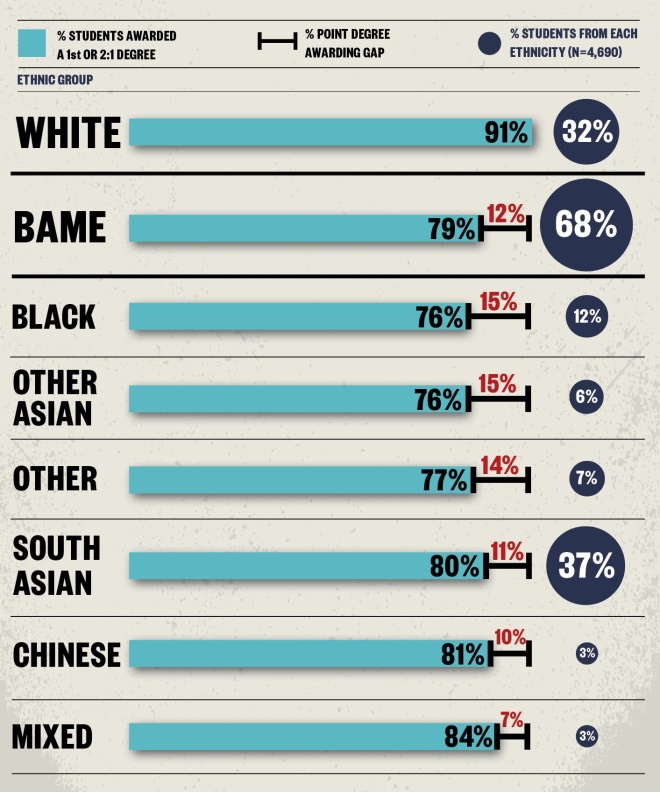
Shutterstock.com
An analysis of data by The Pharmaceutical Journal
has revealed for the first time that a significantly lower proportion of black, Asian and minority ethnic (BAME) students are awarded a higher MPharm degree, compared with their white counterparts.
The data from all 4,690 students with a recorded ethnicity who graduated with an MPharm degree in 2017/2018 and 2018/2019 were provided by the Higher Education Statistics Agency (HESA) and indicate that 91% of white students were awarded first class or upper second class honours, compared with 79% of BAME students over the same time period.
This 12-percentage-point gap is statistically significant and comparable to the overall awarding gap seen for all UK degrees; the latest data show a 13-percentage-point gap between white and BAME students on average.
However, there are significantly larger gaps for some groups of pharmacy students, with a 15-percentage-point gap for those with black and “other Asian” ethnicity, compared with white students, and a 14-percentage-point gap for those with “other” ethnicity.
The awarding gap was smaller for those with South Asian ethnicity (11 percentage points), Chinese students (10 percentage points) and mixed ethnicity students (7 percentage points); however, for all minority ethnicities analysed there was a statistically significant difference in the awarding of higher degrees, compared with white students.
The government’s Office for Students has set a target for all universities in England to improve degree outcomes for underrepresented students, including those from minority ethnic backgrounds.
There was considerable variation between pharmacy schools, with 18 schools showing awarding gaps of up to 37 percentage points in favour of white students. However, four schools showed gaps in favour of those with BAME ethnicity of up to five percentage points. Only one pharmacy school, the University of Strathclyde, showed no awarding gap on the basis of ethnicity.

Figure 1: Ethnicity degree awarding gap revealed between white and BAME pharmacy students
Our analysis of Higher Education Statistics Agency (HESA) data for academic years 2017/2018 and 2018/2019 suggests there is a 12-percentage-point awarding gap (also known as attainment gap) between white pharmacy students and black, Asian and minority ethnic (BAME) pharmacy students in the UK, with 91% of white students and 79% of BAME students being awarded a first or 2:1 (P<0.01). This is similar to the gap of 13 percentage points reported by Universities UK for all 2017/2018 graduates. The largest awarding gap is between black and white students, and other Asian and white students, but gaps between white students and those from all other ethnic groups are also statistically significant (P<0.01 for black, other Asian, other, South Asian and Chinese; P<0.05 for mixed). Our analysis of both national and university-level data excludes students of unknown ethnicity and does not account for other potential confounding factors e.g. socio-economic background, degree choice preference, gender, qualification on entry or international student schemes, and it does not consider students who did not complete the degree. The University of Central Lancashire and Robert Gordon University were excluded due to lack of degree classification data
In a statement, the Pharmacy Schools Council (PhSC) said that any awarding gap is “unacceptable” and that it is committed to equity of opportunity for students.
A spokesperson for the PhSC said: “We recognise that the responsibility lies with the universities to ensure that all our students, regardless of background, do not experience unfair obstacles, including any form of racism, within their degrees that prevent them from achieving their full academic potential.”
They added that schools had “active programmes” in place examining data and developing interventions to close gaps.
The PhSC released a position statement earlier this month on enhancing support for BAME students and colleagues in the wake of George Floyd’s murder and increasing awareness of the Black Lives Matter movement.
The General Pharmaceutical Council (GPhC) said that it had consulted on changes to its standards on pharmacy training that would “strengthen requirements in relation to equality, diversity and inclusion”, including requiring course providers to conduct annual equality reviews.
A spokesperson added: “We are continuing our work to understand the factors that may affect the marks awarded to students and trainees who share particular protected characteristics, including ethnicity, and to identify what we and others can do to support students and trainees throughout their education and training.”
A spokesperson from the British Pharmaceutical Students’ Association (BPSA) said: “More needs to be done to make students from all groups feel like they belong and are able to create strong personal and professional links at university.”
Amandeep Doll, inclusion and diversity co-ordinator at the Royal Pharmaceutical Society, said that strong leadership was needed to reduce the ethnicity awarding gap, with the creation of “inclusive environments” at places of study.
She added: “The significant variations in the awarding gap for BAME pharmacy students is an issue which must be addressed. It’s unacceptable and is a focus of our new inclusion and diversity strategy.
“We’ll be working with the Pharmacy Schools Council, GPhC, UK Black Pharmacists Association, the Black Pharmacists Collective and BPSA on this complex problem, which requires a variety of approaches.”
Our methodology
The investigation into the MPharm awarding gap forms part of The Pharmaceutical Journal’s
PJMindTheGap campaign, which has previously highlighted a number of inequalities for different ethnic groups in pharmacy.
Figures were acquired from the Higher Education Statistics Agency (HESA), the UK designated higher education data body, and the analysis was undertaken by The Pharmaceutical Journal on data derived from the HESA Student Record for combined academic years 2017/2018 and 2018/2019.
Data were based on all MPharm first degree qualifiers within the UK in those years, broken down by ethnicity and school of pharmacy attended. Students classified as ‘unknown ethnicity’ were not included in the analysis. Pharmacy schools without degree classification data or who had small numbers of students from either white or black, Asian and minority ethnic backgrounds were also excluded.
Percentage levels of awarding were determined for first class or upper second class MPharm degrees for white students and students belonging to a minority ethnic background, and the percentage point gap between the two calculated. Published results were rounded in accordance with HESA’s Standard Rounding Methodology.
An independent biostatistician recommended use of the chi-squared test to determine independence of ethnicity and awarding of a higher degree class for national data only. Statistical significance indicates the two variables are not independent.
HESA data were based on full person equivalents and not adjusted for grades on admission to pharmacy school, degree choice, gender, socioeconomic background, or involvement in widening participation or international student schemes.
Neither HESA or HESA Services, Jisc or Jisc Services can accept responsibility for any inferences or conclusions derived by third parties from data or other information supplied by the Higher Education Statistics Agency Limited or HESA Services Limited.
The Royal Pharmaceutical Society launched its pharmacy inclusion and diversity programme in August 2019. Find out more about what the Society is doing for members here.



